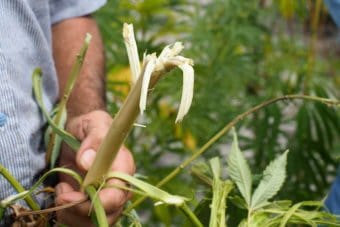Construction of the first hemp house in WA has just been completed, sparking calls to build a local processing plant so local farmers can supply the building industry.
The hemp plant’s woody stem is shredded, mixed with a lime render and tampered into place inside a timber frame.
Builder Gary Rogers said hemp is a high thermal insulator.
“The hemp is basically encased around your timber frame home so in a nutshell it’s your cladding, it’s your insulation, and it’s all your gyprock and basically all your painting, all done in one, in a monolithic wall,” Mr Rogers said.
The hemp walls are also termite resistant, fireproof, breathable, prevent mould, store carbon and reduce the need for heating and cooling.
And with the plant reaching maturity for hemp fibre requirements in just 14 weeks, it has been touted as an environmentally friendly answer to the building industry.
Mr Rogers used some locally grown and milled hemp to build the Margaret River home but he could not source enough product for a house.
At the moment, processed hemp needs to be imported from the east coast and Europe.
“We can import building materials to try and get it going and that’s what we’re doing at the moment, working with a couple of builders to import it so we can actually build interest in the industry,” Colin Steddy, director of the The Hemp Corporation, said.
Hemp growers face uphill battle
But local hemp growers said they could grow hemp plants but just needed a processing plant in WA because their product was going to waste.
Gail Stubber, a South West hemp grower, said regulations prevented her from selling the seed as a food product.
“I can grow this crop but I can’t do anything with it,” Ms Stubber said.
“The only thing I can do with the seed is either replant it next year if it doesn’t go high THC or I can have it pressed down into an oil, which is not really the way I want to go.”
There were strict regulations ensuring the amount of THC in the plant was low, but Ms Stubber said that was not the biggest hurdle.
“I’d like the seed to be used for food because that immediately makes my crop more valuable,” she said.
“I would like them to give us some sort of ruling on if the THC is slightly high, whether we can use the bi-products that are not involved in the high THC, so the herd, the inside part which is the housing thing.
“And I’d like the government to give us a hand, be it with a grant or something, to actually get a processing mill here in the South West.
“It’s closed a lot mills, a lot of paper and pulp mills, but maybe we can turn one of those mills, whether it be at Kirup or Nannup or something into a hemp mill and produce herd for housing.”
Colin Steddy said he planned to privately fund a processing plant in the South West which he said would open the door to huge farming and textile industry opportunities.
Mr Rogers said he already had several more clients lined up to build their homes from hemp.



